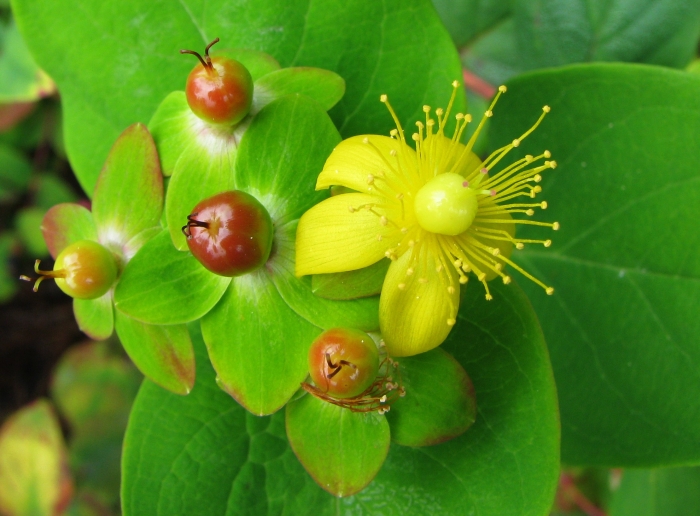Sweet-Amber
(Hypericum androsaemum)
Sweet-Amber (Hypericum androsaemum)
/
/

Agnieszka Kwiecień (Nova)
CC BY 3.0
Image By:
Agnieszka Kwiecień (Nova)
Recorded By:
Copyright:
CC BY 3.0
Copyright Notice:
Photo by: Agnieszka Kwiecień (Nova) | License Type: CC BY 3.0 | License URL: https://creativecommons.org/licenses/by/3.0 | Uploader: Nova | Publisher: Wikipedia Commons | Title: Hypericum_androsaemum_Dziurawiec_barwierski_01.jpg | Notes: Sweet-amber Hypericum androsaemum flower and young fruits, plant cultivated in Wrocław University Botanical Garden, Poland. | ObjectName: Hypericum androsaemum Dziurawiec barwierski 01 | UsageTerms: Creative Commons Attribution 3.0 |











































































Estimated Native Range
Summary
Hypericum androsaemum, commonly known as Sweet-Amber or Tutsan, is a deciduous shrub native to open woodlands and forest edges in Southern Europe, the Middle East, and North Africa. It typically grows to a height and width of 2-3 feet (0.6-0.9 meters), forming a dense, bushy mound. Sweet-Amber is characterized by its oval to oblong, dark green leaves and star-shaped, bright yellow flowers that bloom in the spring and summer, followed by red berries that mature to a glossy black. The flowers are moderately showy and attract pollinators.
This shrub is valued for its ornamental features, including its attractive berries and its ability to provide year-round interest in the garden. It is used in border plantings, as a ground cover, and in naturalized areas. Sweet-Amber thrives in full sun to part shade and prefers well-drained soil, although it is tolerant of a range of soil conditions. It requires moderate watering but can withstand periods of drought once established. While generally low-maintenance, it can be susceptible to rust and leaf spot diseases. Gardeners should be aware of its potential invasiveness, particularly in regions like California, and should consult local regulations before planting.CC BY-SA 4.0
This shrub is valued for its ornamental features, including its attractive berries and its ability to provide year-round interest in the garden. It is used in border plantings, as a ground cover, and in naturalized areas. Sweet-Amber thrives in full sun to part shade and prefers well-drained soil, although it is tolerant of a range of soil conditions. It requires moderate watering but can withstand periods of drought once established. While generally low-maintenance, it can be susceptible to rust and leaf spot diseases. Gardeners should be aware of its potential invasiveness, particularly in regions like California, and should consult local regulations before planting.CC BY-SA 4.0
Plant Description
- Plant Type: Shrub
- Height: 2-3 feet
- Width: 2-3 feet
- Growth Rate: Rapid
- Flower Color: Yellow
- Flowering Season: Spring, Summer
- Leaf Retention: Deciduous
Growth Requirements
- Sun: Full Sun, Part Shade
- Water: Medium
- Drainage: Slow, Medium, Fast
Common Uses
Bank Stabilization, Bee Garden, Bird Garden, Border Plant, Butterfly Garden, Deer Resistant, Drought Tolerant, Erosion Control, Fragrant, Groundcover, Hedges, Rock Garden, Street Planting
Natural Habitat
Open woodlands and forest edges
Other Names
Common Names: Tutsan, Shrubby St. John’s Wort, Androsème, Millepertuis Androsème, Toute-Naine, Mansbloed, Läkehyperikum
Scientific Names: , Hypericum androsaemum, Androsaemum officinale, Hypericum webbianum, Hypericum anglicum, Hypericum floridum, Androsaemum androsaemum, Androsaemum floridum, Androsaemum vulgare, Hypericum bacciferum
GBIF Accepted Name: Hypericum androsaemum L.